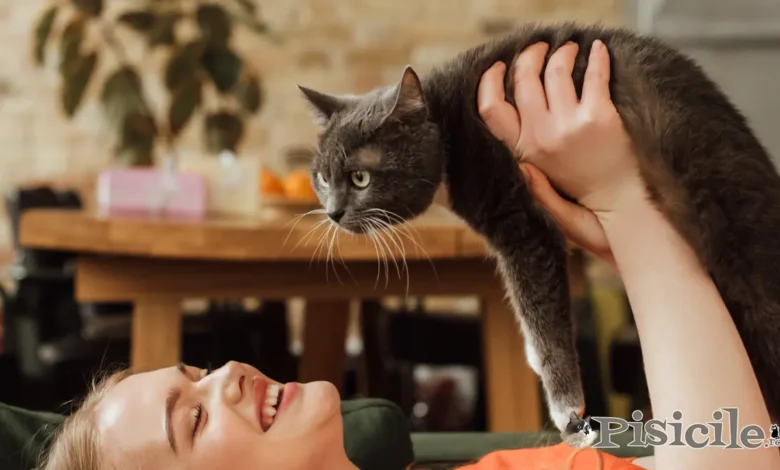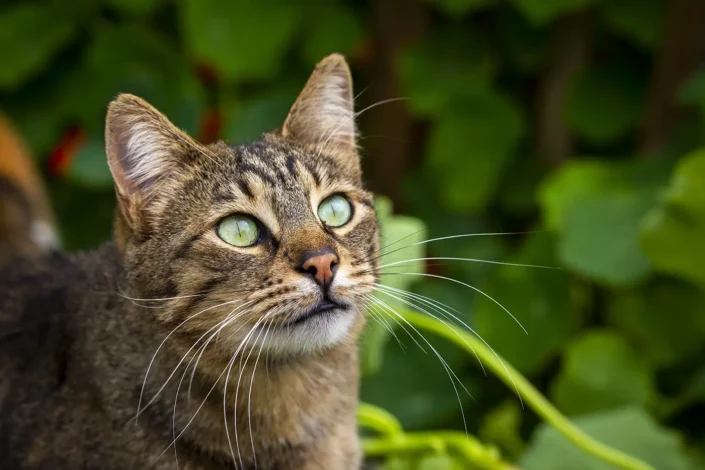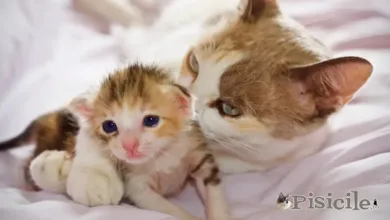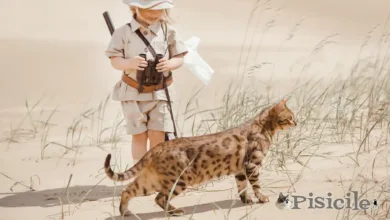
From Felis lybica, the first domesticated cat about 9,000 years ago, to the present day, people have sought to discover more and more mysteries and interesting curiosities about cats. An interesting article is "The Mysteries of Cats in Religions and Cultures Around the World", where you can find out what the cat meant and means to people throughout the millennia.
Cats are certainly the most popular pets in many countries around the globe. They are loving, playful, energetic, playful animals who very often do funny things that make us laugh. To discover these felines even more, in this article we have prepared 30 interesting curiosities about cats.
30 interesting facts about cats.
The largest breed of domestic cat is the Maine Coon. Males can weigh between 6 and 9 kg and females between 4 and 6 kg. Some specimens can even reach 11-15 kg and over 100 cm in length. The Maine Coon cat has a long, muscular body with bushy fur and strong legs.
The smallest cat breed in the world is the Singapura. Cats of this breed are known for their extremely small and delicate size. These cats have a small body, large ears and expressive eyes. Singapura males weigh between 2 and 3 kg and females between 1.8 and 2.7 kg. The dimensions are of a petite cat. Length of 20-30 cm (from head to tail) and are not higher than 10-15 cm.
A domestic cat lives on average 15-16 years. Urban (or stray) cats live an average of 3-5 years. If you want to discover more interesting curiosities about cats and how long they can live, you can also see our article: How many years does a cat live and what are the life stages.
On average, cats give birth to about 4-6 kittens at a time, twice a year. However, there are breeds such as the Maine Coon that can give birth to 12 puppies at once. Burmese and Siamese cat breeds can give birth to up to 10 kittens in a single birth (calving). There is nothing abnormal if the cat gives birth to only one kitten.
Blue Bell, a Persian cat from South Africa, gave birth to 14 kittens in 1975. This amazing birth was a surprise even to her owners, who did not expect such a large number of kittens.
Cats can see in the dark, but they cannot see in absolute darkness. Although they have night vision six times better than humans, cats cannot see in absolute darkness. To see in the dark, the cat needs as little source of light as possible.
Cats do not taste sweet. This is a unique feature compared to many other mammals. Cats' inability to taste sweet is due to a genetic defect in their taste receptors. However, the cat will be tempted to taste the cake, cookies or chocolate (which is not recommended).

Cats can distinguish colors. One of the biggest interesting curiosities about cats is their eyesight. Compared to dogs, cats see colors, but not the same way humans do. Cats see a narrow range of colors, predominantly in shades of blue and green, and have difficulty distinguishing between red and green.
Cats' brains are more developed than dogs'. From the chapter of interesting curiosities for cats, we cannot fail to mention their brains. Cats' brains have about 300 million neurons, while dogs have about 160 million neurons. However, the dog's brain is larger than the cat's.
Cats have small brains. Although it is very well developed, the cat's brain represents only 0.9% of the body mass. The cat's brain has a surface with amazing cerebral convolutions and a structure that is about 90% similar to ours.
The sense of smell is 14 times more developed than that of humans. This sense is present from the first moment of life, and the cat uses it to identify objects, food and people.
Kittens can't see or hear. They are born deaf and blind (with their eyes glued shut). Kittens begin to open their eyes and see 7 to 10 days after birth. Between 5 and 10 days will pass before the kittens start to hear. Throughout this period they rely on smell and tactile senses.
Also read: 15 interesting facts about kittens
Cats sleep an average of 16 hours a day. You don't have to worry if your cat sleeps a lot. An adult cat sleeps between 12 and 16 hours a day, but some cats can sleep up to 20 hours. The length of the sleeping period increases with the age of the cat. They spend about 70% of their lives sleeping.
Did you know that cats dream? From the age of one week, cats start to dream. Don't be surprised if your cat starts moving its paws, ears or nose in its sleep. He is most likely dreaming that he is hunting. Some cats even wake up upset and start meowing, a sign that it was a very intense dream.
Cats spend 30% of their time grooming. When they are not sleeping, cats brush their fur with their tongues to keep themselves clean.
The cat has 24 whiskers full of tactile sensors. The cat's whiskers are very sensitive to movements and vibrations, helping the cat to detect objects and obstacles around it, even in complete darkness. The cat uses its whiskers to measure the spaces it passes through. The whiskers are long enough to help the cat gauge the width of a space, giving it confidence that it can get through without getting stuck.

The cat's nose is unique to each specimen. The surface of the cat's nose has a unique fingerprint, just like human fingerprints.
Cats cannot move their jaw sideways. From the list of interesting cat curiosities, the anatomy of the jaw is one of the most amazing. Although they have a very good predatory ability, the cat's jaw can only move up and down, not sideways like it is in humans. This anatomical feature does not allow cats to chew large pieces of food.
The cat can rotate its ears 180 degrees. Cats' ears are controlled by 32 muscles, compared to only 6 in humans. Each ear can be moved independently of the other. This allows them to pinpoint the source of sounds.
Did you know cats have freckles? These interesting curiosities about cats are little noticed by owners. Tabby, orange cats have freckles on their eyelids and around their mouths.
Cats only meow when communicating with humans. Cats do not meow to communicate with each other. In the wild, adult cats do not meow to interact with other cats. Cats use other means of communication such as body postures, olfactory signals, hissing and growling. When you hear a cat meow, it wants to tell you something.
Cats are pacifists. When outside, cats will never seek to conflict with other cats just to show their superiority. Most conflicts are based on territorial protection. The biggest fights are between motans, during the mating season, when they visit ladies from other territories.
The torso of cats has healing powers for humans. Over time, it has been observed that cat purring is not only a pleasant and soothing sound, but also one that can bring therapeutic benefits. Cats' torsos produce vibrations with frequencies between 25 and 150 Hz, a range that has been associated with tissue healing and regeneration. Vibrations with these frequencies help heal bones, reduce inflammation and relieve pain.
Cats can interpret the tone of the human voice. The cat knows when you pet it or when you scold it. They have the ability to interpret the tone of the human voice very well.
The cat only sweats through the paw pads. Compared to humans, who can sweat all over their skin, cats only sweat through their pads. This is their way of regulating their body temperature. Pad sweating can also occur if the cat is feeling very sick or stressed.
Interesting curiosities about cat tails. The cat's tail is multi-functional. I know it might sound funny, but it's true. The cat uses its tail to communicate and express its mood, for coordination and balance, but also for thermal insulation. In cold climates, cats may use their tails to cover their noses and faces, helping to conserve body heat.
How many hairs does a cat have? If you have asked yourself this question, it is recommended to believe the studies and not start counting every strand of the cat's fur. Research has shown that cats have an average of 60,000 to 200,000 hairs per square centimeter.
Cats almost always fall on their feet. From this ability came the saying that cats have 9 lives. Cats have a remarkable ability to always land on their feet thanks to a reflex called aerial righting reflex. This reflex allows them to spin quickly in the air to land on their feet. Although the righting reflex is done in less than a second, the cat needs a height of at least 30 cm to land on its feet.
Cats are real sopranos. Cats have a wide range of sounds they can make, estimated at around 100 different sounds. Compared to dogs, who can only make 10 sounds, cats are true sopranos. They can emit from a simple "meow" of greeting, to growling, purring, hissing, screaming or chirping.
Cats talk to people. The more you talk to your cat, the more often he will talk back to you. Cats use meowing to communicate with humans.
– Miau!
– Meow, you too!



